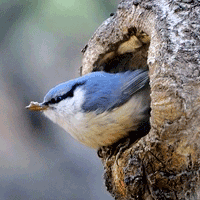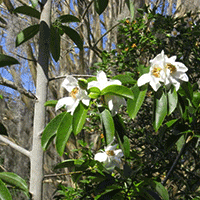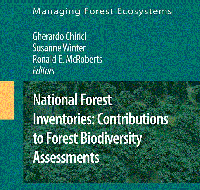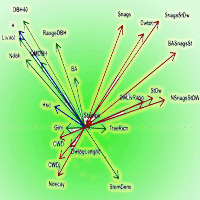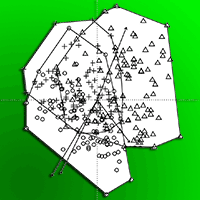Tree cavities are important structural elements of forest ecosystem that host numerous birds, mammals and other cavity-dependent organisms. Pattern of cavity distribution in temperate and boreal forests are relatively well studied, yet little is known about cavities in tropical and subtropical forests. We compared cavity availability in relation to tree condition (living tree and snag), tree species and DBH class between two different sites in a subtropical deciduous sal forest in Nepal: the Chitwan National Park Forest (the park site) and the Khorsor Buffer Zone Forest (the buffer site). Surveys for tree cavities were conducted in 2013 on 50 circular sample plots of size 0.1 ha. We recorded 40 cavity trees in the park site and 31 cavity trees in the buffer site. Density of cavities was on average 22.4 ha-1 in the park site and 19.2 ha-1 in the buffer site. Cavities occurred mostly in living trees (85.9% cavity trees) and were formed mostly by damage and decay (natural cavities: 74%) or by woodpecker activity (excavated cavities: 26%). Most were observed on three tree species: Shorea robusta, Dillenia pentagyna and Syzygium operculatum, with a mean diameter of 43 cm (range: 12-111 cm). S. operculatum, Myrsine semiserrata and Semecarpus anacardium were overrepresented among tree species with cavities. In snags, 25.0% of all cavities were found in the park site and 8.3% in the buffer site, while snags represented 4.2% and 2.2% of all trees in the two sites, respectively. Statistical anaysis indicated that tree species, tree condition and particularly diameter (DBH) were important variables for the prediction of cavity presence. We recommend cavity-bearing tree species to be better protected by forest management in order to help maintain the community of cavity dwellers.
Keywords
, , , ,
Citation
Bhusal P, Czeszczewik D, Walankiewicz W, Churski M, Baral R, Lamichhane BR, Mikusinski G (2015). Availability of tree cavities in a sal forest of Nepal. iForest 9: 217-225. - doi: 10.3832/ifor1493-008
Academic Editor
Massimo Faccoli
Paper history
Received: Nov 05, 2014
Accepted: Jul 08, 2015
First online: Oct 16, 2015
Publication Date: Apr 26, 2016
Publication Time: 3.33 months
© SISEF - The Italian Society of Silviculture and Forest Ecology 2015
Open Access
This article is distributed under the terms of the Creative Commons Attribution-Non Commercial 4.0 International (https://creativecommons.org/licenses/by-nc/4.0/), which permits unrestricted use, distribution, and reproduction in any medium, provided you give appropriate credit to the original author(s) and the source, provide a link to the Creative Commons license, and indicate if changes were made.

Breakdown by View Type
(Waiting for server response...)
Article Usage
Total Article Views: 51435
(from publication date up to now)
Breakdown by View Type
HTML Page Views: 43077
Abstract Page Views: 3191
PDF Downloads: 3900
Citation/Reference Downloads: 13
XML Downloads: 1254
Web Metrics
Days since publication: 3715
Overall contacts: 51435
Avg. contacts per week: 96.92
Article Citations
Article citations are based on data periodically collected from the Clarivate Web of Science web site
(last update: Mar 2025)
Total number of cites (since 2016): 7
Average cites per year: 0.70
Publication Metrics
by Dimensions ©
Articles citing this article
List of the papers citing this article based on CrossRef Cited-by.
(1)
Aitken KEH, Martin K (2004)Nest cavity availability and selection in aspen-conifer groves in a grassland landscape. Canadian Journal of Forest Research 34: 2099-2109.
CrossRef |
Gscholar
(2)
Aitken KEH, Martin K (2007)The importance of excavators in hole nesting communities: availability and use of natural tree holes in old mixed forests of western Canada. Journal of Ornithology 148: 425-434.
CrossRef |
Gscholar
(3)
Angelstam P, Mikusinski G (1994)Woodpecker assemblages in natural and managed boreal and hemiboreal forest - a review. Annales Zoologici Fennici 31: 157-172.
Online |
Gscholar
(4)
Bai ML, Wichmann F, Mühlenberg M (2003)The abundance of tree holes and their utilization by hole-nesting birds in a primeval boreal forest of Mongolia. Acta Ornithologica 38: 95-102.
CrossRef |
Gscholar
(5)
Bakshi BK (1957)Heart rot in relation to management of Sal. Indian Forester 83: 651-661.
Gscholar
(6)
Boyle WA, Ganong CN, Clark DB, Hast MA (2008)Density, distribution and attributes of tree cavities in an old-growth tropical rain forest. Biotropical 40: 241-245.
CrossRef |
Gscholar
(7)
Bull EL, Peterson SR, Thomas JW (1986)Resource partitioning among woodpeckers in northeastern Oregon. Pacific Northwest Research Station, USDA Forest Service, Portland, OR, USA, pp. 19.
Online |
Gscholar
(8)
Burnham KP, Anderson R (2002)Model selection and multi-model inference: a practical information-theoretic approach (2nd edn). Springer-Verlag, New York, USA, pp. 83.
Gscholar
(9)
Carlson A, Sandström U, Olsson K (1998)Availability and use of natural tree holes by cavity nesting birds in a Swedish deciduous forest. Ardea 86: 109-119.
Online |
Gscholar
(10)
Cockle KL, Martin K, Drever MC (2010)Supply of tree-holes limits nest density of cavity-nesting birds in primary and logged subtropical Atlantic forest. Biological Conservation 143: 2851-2857.
CrossRef |
Gscholar
(11)
Cockle KL, Martin K, Wesolowski T (2011)Woodpeckers, decay, and the future of cavity-nesting vertebrate communities worldwide. Frontiers in Ecology and the Environment 9: 377-382.
CrossRef |
Gscholar
(12)
Cooke HA, Hannon SJ (2011)Do aggregated harvests with structural retention conserve the cavity web of old upland forest in the boreal plains? Forest Ecology and Management 261: 662-674.
CrossRef |
Gscholar
(13)
Cornelius C, Cockle K, Politi N, Berkunsky I, Sandoval L, Ojeda V, Rivera L, Hunter Jr M, Martin K (2008)Cavity-nesting birds in neotropical forests: cavities as a potentially limiting resource. Ornitologia Neotropical 19: 253-268.
Gscholar
(14)
Czeszczewik D, Walankiewicz W (2003)Natural nest sites of the Pied Flycatcher in a primeval forest. Ardea 91: 221-230.
Online |
Gscholar
(15)
Czeszczewik D, Walankiewicz W, Mitrus C, Tumiel T, Stanski T, Sahel M, Bednarczyk G (2013)Importance of dead wood resources for woodpeckers in coniferous stands of the Bialowieza Forest. Bird Conservation International 23: 414-425.
CrossRef |
Gscholar
(16)
Czeszczewik D, Zub K, Stanski T, Sahel M, Kapusta A, Walankiewicz W (2015)Effects of forest management on bird assemblages in the Bialowieza Forest, Poland. iForest 8 (3): 377-385.
CrossRef |
Gscholar
(17)
DNPWC (2011)Annual report. Government of Nepal, Ministry of Forest and Soil Conservation, Department of National Park and Wildlife Conservation, Kathmandu, Nepal, pp. 100.
Gscholar
(18)
Edington JM, Edington MA (1972)Spatial patterns and habitat partition in the breeding birds of an uplandwood. Journal of Animal Ecology 41: 331-357.
CrossRef |
Gscholar
(19)
Gautam KH, Devoe NN (2005)Ecological and anthropogenic niches of sal (
Shorea robusta Gaertn. F.) forest and prospects for multiple-product forest management - a review. Forestry 79: 81-101.
CrossRef |
Gscholar
(20)
Gibbons P, Lindenmayer D (2002)Tree hollows and wildlife conservation in Australia. CSIRO Publishing, Melbourne, Australia, pp. 211.
Online |
Gscholar
(21)
Gibbs JP, Hunter ML, Melvin SM (1993)Snag availability and communities of cavity-nesting birds in tropical
versus temperate forests. Biotropica 25: 236-241.
CrossRef |
Gscholar
(22)
Hosmer DW, Jovanovic B, Lemeshow S (1989)Best subsets logistic regression. Biometrics 45: 1265-1270.
CrossRef |
Gscholar
(23)
Hussain I, Abbasi S, Mirza SN, Anwar M, Rais M, Mahamood T (2013)Tree cavities and associated vertebrate fauna in a coniferous forest of Dhirkot, Azad Jammu and Kashmir part of Pakistan. Turkish Journal of Zoology 37: 647-658.
CrossRef |
Gscholar
(24)
Jacobs J (1974)Quantitative measurement of food selection. A modification of the forage ratio and Ivlev’s electivity index. Oecologia 14: 413-417.
CrossRef |
Gscholar
(25)
Kennedy RSH, Pabst RJ, Olsen KA, Spies TA (2010)Potential future dead wood dynamics in a multi-ownership region: the coastal province of Oregon, USA. Forest Ecology and Management 259: 312-322.
CrossRef |
Gscholar
(26)
Khanna LS, Chaturvedi AN (2012)Handbook of Forestry (4th edn). Khanna Bandhu 7, Tilak Road, Deheradun, India, pp. 206.
Gscholar
(27)
Kumar R, Shahabuddin G, Kumar A (2011)How good are managed forests at conserving native woodpecker communities? A study in sub-Himalayan dipterocarp forests of northwest India. Biological Conservation 144: 1876-1884.
CrossRef |
Gscholar
(28)
Lammertink M (2004)A multiple-site comparison of woodpecker communities in Bornean lowland and hill forests. Conservation Biology 18: 746-757.
CrossRef |
Gscholar
(29)
Lõhmus A, Lõhmus P, Remm J, Vellak K (2005)Old-growth structural elements in a strict reserve and commercial forest landscape in Estonia. Forest Ecology and Management 216: 201-215.
CrossRef |
Gscholar
(30)
Mikusinski G (2006)Woodpeckers (Picidae) - distribution, conservation and research in a global perspective. Annales Zoologici Fennici 43: 86-95.
Gscholar
(31)
Müller-Böcker U (1991)Knowledge and evaluation of the environment in traditional societies of Nepal. Mountain Research and Development 11: 101-114.
CrossRef |
Gscholar
(32)
Nepal SK, Weber KE (1995)The quandary of local people-park relations in Nepal’s Royal Chitwan National Park. Environmental Management 19: 853-866.
CrossRef |
Gscholar
(33)
Newton I (1994)The role of nest-sites in limiting the number of hole-nesting birds: a review. Biological Conservation 70: 265-276.
CrossRef |
Gscholar
(34)
Newton I (1998)Population limitation in birds. Academic Press, San Diego, CA, USA, pp. 597.
Online |
Gscholar
(35)
Orwa C, Mutua A, Kindt R, Jamnadass R, Simons A (2009)Agroforestree database: a tree reference and selection guide version 4.0. World Agroforestry Centre (ICRAF), Nairobi, Kenya.
Online |
Gscholar
(36)
Pattanavibool A, Edge WD (1996)Single-tree selection silviculture affects cavity resources in mixed deciduous forests in Thailand. Journal of Wildlife Management 60: 67-73.
CrossRef |
Gscholar
(37)
Poulsen BO (2002)Avian richness and abundance in temperate Danish forests: tree variables important to birds and their conservation. Biodiversity and Conservation 11: 1551-1566.
CrossRef |
Gscholar
(38)
R Development Core Team (2013)R: a language and environment for statistical computing. R Foundation for Statistical Computing, Vienna, Austria.
Online |
Gscholar
(39)
Remm J, Lõhmus A (2011)Tree cavities in forest - The broad distribution pattern of keystone structure for biodiversity. Forest Ecology and Management 262: 579-585.
CrossRef |
Gscholar
(40)
StatSoft I (2011)STATISTICA - data analysis software system, version 10. Web site.
Online |
Gscholar
(41)
Straede S, Helles F (2000)Park-people conflict resolution in Royal Chitwan National Park, Nepal: buying time at high cost? Environmental Conservation 27: 368-381.
CrossRef |
Gscholar
(42)
Straede S, Treue T (2006)Beyond buffer zone protection: a comparative study of park and buffer zone products’ importance to villagers living inside Royal Chitwan National Park and to villagers living in its buffer zone. Journal of Environmental Management 78: 251-267.
CrossRef |
Gscholar
(43)
Tidemann CR, Flavel SC (1987)Factors affecting choice of diurnal roost site by tree-hole bats (Microchiroptera) in south-eastern Australia. Australian Wildlife Research 14: 459-473.
CrossRef |
Gscholar
(44)
Von Haartman L (1957)Adaptation in hole-nesting birds. Evolution 11: 339-347.
CrossRef |
Gscholar
(45)
Vázquez L, Renton K (2015)High density of tree-cavities and snags in tropical dry forest of western Mexico raises questions for a latitudinal gradient. PLoS One 10: e0116745.
CrossRef |
Gscholar
(46)
Walankiewicz W (1991)Do secondary cavity-nesting birds suffer more from competition for cavities or from predation in a primeval deciduous forest? Natural Areas Journal 11: 203-212.
Gscholar
(47)
Walankiewicz W, Czeszczewik D, Mitrus C (2007)Natural nest sites of the Collared Flycatcher
Ficedula albicollis in lime-hornbeam-oak stands of a primeval forest. Ornis Fennica 84: 155-162.
Gscholar
(48)
Walankiewicz W, Czeszczewik D, Mitrus C, Bida E (2002)Znaczenie martwych drzew w lasach lisciastych dla zespolu dzieciolów w Puszczy Bialowieskiej [Snag importance for woodpeckers in deciduous stands of the Bialowieza Forest]. Notatki Ornitologiczne 43: 61-71. [in Polish]
Gscholar
(49)
Walankiewicz W, Czeszczewik D, Stanski T, Sahel M, Ruczynski I (2014)Tree cavity resources in spruce-pine managed and protected stands of the Bialowieza Forest, Poland. Natural Areas Journal 34: 501-515.
CrossRef |
Gscholar
(50)
Walankiewicz W, Czeszczewik D, Tumiel T, Stanski T (2011)Woodpeckers abundance in the Bialowieza Forest - a comparison between deciduous, strictly protected and managed stands. Ornis Polonica 52: 161-168.
Gscholar
(51)
Waters JR, Noon BR, Verner J (1990)Lack of nest site limitation in a cavity-nesting bird community. Journal of Wildlife Management 54: 239-245.
CrossRef |
Gscholar
(52)
Wesolowski T (1996)Natural nest sites of Marsh Tits
Parus palustris in a primaeval forest (Bialowieza National Park, Poland). Die Vogelwarte 38: 235-249.
Gscholar
(53)
Wesolowski T (2005)Virtual conservation: how the European Union is turning a blind eye to its vanishing primeval forests. Conservation Biology 19: 1349-1358.
CrossRef |
Gscholar
(54)
Wesolowski T (2011)“Lifespan” of woodpecker-made holes in a primeval temperate forest: a thirty-year study. Forest Ecology and Management 262: 1846-1852.
CrossRef |
Gscholar
(55)
Wesolowski T (2012)“Lifespan” of non-excavated holes in a primeval temperate forest: a 30 year study. Biological Conservation 153: 118-126.
CrossRef |
Gscholar
(56)
Yanovlak SP (2001)The macrofauna of water-filled tree holes on Barro Colorado Island, Panama. Biotropica 33: 110-120.
CrossRef |
Gscholar



